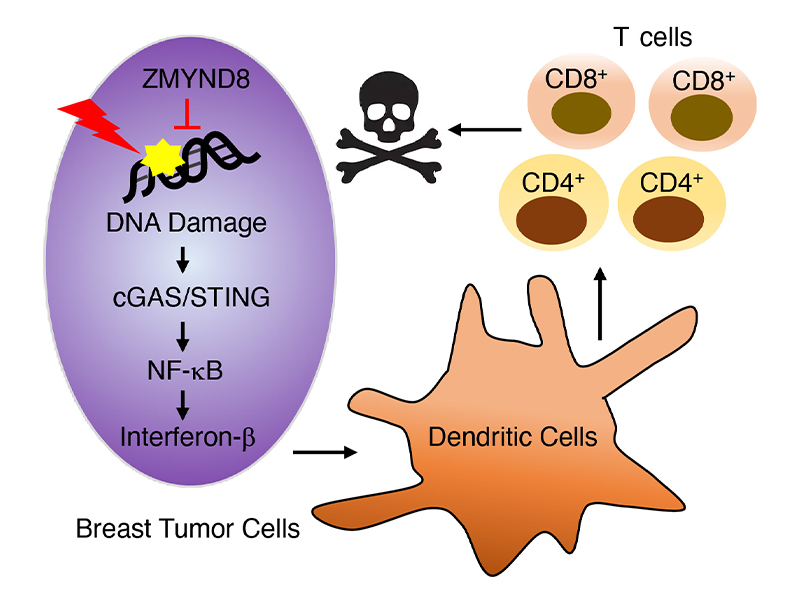UTSW researchers identify new gene involved in breast cancer growth

DALLAS – Jan. 12, 2021 – A team of UT Southwestern researchers has identified a gene involved in the growth of breast cancer, a finding that could lead to potential new targets for treatment.

“The gene ZMYND8 is increased in breast cancer conditions, and higher levels of the gene correlate with poor survival of breast cancer patients,” says Yingfei Wang, Ph.D., assistant professor of pathology and neurology and corresponding author of the new study, published in Cancer Research. “It could be a promising target for antitumor immunotherapy.”
In the U.S., about 1 in 8 women will develop breast cancer at some point in their life. Worldwide, breast cancer is the most common cancer type and is the second leading cause of cancer death among women; yet there remains a need for more effective treatments for this disease.
The researchers found that ZMYND8 regulates the stability of an organism’s DNA, or genome. When a cell’s DNA is damaged, the genome becomes unstable and signals to the body to destroy the cell through use of the immune system. Specialized cells called lymphocytes then infiltrate DNA-damaged cells to stop them from propagating. Although genome instability is a hallmark of cancer, some cancer cells develop immunity from this response, and it is not completely understood how.
The UTSW researchers found that high levels of ZMYND8 in breast cancer cells suppress antitumor immunity by inhibiting DNA damage and preventing lymphocytes from finding the cancer cells. So, the team asked what would happen to breast cancer cells if they removed, or knocked out, the gene for ZMYND8. When they did this in breast cancer cells in mouse models, the researchers discovered that lymphocytes were able to invade the tumors and prevent growth.
Though it remains to be seen if reducing ZMYND8 in humans will have the same effect, the authors found that this gene is upregulated in approximately 10 percent of breast cancer patients. Thus, ZMYND8 could be a promising target for immunotherapy that warrants further investigation.
What are the next steps then?

“We are very interested in identifying small molecule inhibitors of ZMYND8,” says Weibo Luo, Ph.D., assistant professor of pathology and pharmacology and another corresponding author of the study. By finding such inhibitors, the researchers hope to develop a new treatment for breast cancer patients that could be used alone or in combination with other treatments, such as immunotherapy.
The research is still in early stages, however, and the authors warn that there is still a lot to learn about this gene. “We don’t know if this gene is critical for maintaining genome stability under physiological conditions,” says Wang. “We need to be really cautious moving forward.”
Identifying ways to specifically target ZMYND8 in breast cancer cells will be important to avoid interfering with other organ systems. The authors are currently exploring the physiological role of ZMYND8 through mouse models.

“ZMYND8 can control tumor progression and spread, or metastasis. The protein is very important, at least in breast cancer, and if we can find inhibitors, we can combine them with other therapies for breast cancer treatment,” says Luo, who is a Cancer Prevention and Research Institute of Texas (CPRIT) Scholar in Cancer Research.
Both Wang and Luo are members of the Harold C. Simmons Comprehensive Cancer Center and corresponding authors on this study who worked closely with cancer immunologist Yang-Xin Fu, M.D., Ph.D., another study contributor, CPRIT Scholar, and holder of the Mary Nell and Ralph B. Rogers Professorship in Immunology. Other UTSW researchers contributing to this study are Yong Wang, Maowu Luo, Yan Chen, Bo Zhang, Zhenhua Ren, Lei Bao, Yanan Wang, and Jennifer E. Wang.
This work was supported by grants from the Mary Kay Foundation (08-19), National Institutes of Health (R01CA222393, R35GM124693 and R01AG066166), CPRIT (RR140036, RP190358, and RP170671), the Susan G. Komen Foundation (CCR16376227), and The Welch Foundation (I-1903-20190330 and I-1939-20160319).
